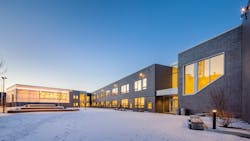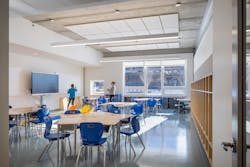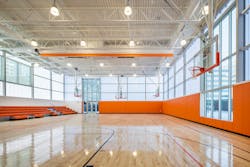PROJECTS | Form follows function when lighting educational spaces
Academic lighting design remains rooted in practicality. That’s not to say that the spaces are stagnant or that the challenges of lighting them aren’t real. It’s simply a matter of balancing form and function, along with practicality and technology, all while making programming the priority. Michael Barber, principal, The Lighting Practice, Philadelphia, explains: “You don’t need to specify tunable light sources, color changing fixtures, or technologically cumbersome products. I try to keep it simple. It’s the union of light and architecture, with a focus on the program. At the end of the day, it’s got to be functional.”
The Lighting Practice has built a portfolio of extraordinary projects based on the fundamental principles of careful listening, collaboration, and dedication to achieving the vision of their clients. The recent Powel SLAMS K-8 school project is just one example.
Opened in 2021, the Powel SLAMS school co-located Powel Elementary School and Science Leadership Academy Middle School (SLAMS) on the Drexel University campus. The 87,000 square-foot, two-story building in West Philadelphia is now open to 720 students.
Barber’s team carefully tailored the lighting design at Powel SLAMS to the function of school spaces. “We were engaged in a few planning and programming sessions to understand what was most important to the client and how the lighting should function and operate,” says Barber. Wayfinding graphics were lit to make them obvious and easy to read. The gated playground was outfitted with building- and pole-mounted small aperture accent lights for security and safe play. And the cafetorium (a multiuse space that doubles as a cafeteria and auditorium) contains downlight cylinders that provide functional light on lunch tables and track lighting fixtures to deliver accent illumination in areas where a stage/podium can be located.
With an emphasis on active learning, interaction, and engagement, the classrooms at Powel SLAMS are lit for high visual acuity. Students today work more collaboratively than in the past. “The concepts are still the same though: put lighting on writing surfaces and provide even ambient illumination,” says Barber. Projections, smart boards, and other tech tools make minimizing glare and reflection a priority, as well as recognizing that all areas of the classroom are being used for instruction. “We have to treat the room more evenly. Writing surfaces are all around the room now,” he adds. The high ceilings of exposed concrete deck meant that a combination of direct/indirect lighting fixtures had to compete for space among acoustic panels to provide even illumination in classrooms. Downlights in the soffit provide light on writing surfaces.
Learning and collaboration also happens in areas outside the classroom and the lighting design supports that. “A corridor isn’t just a corridor anymore. Circulation areas now have spaces carved out of them where people can sit and gather,” Barber explains. At Powel SLAMS, circulation paths contain larger public break-out areas. The Lighting Practice integrated cove lighting to emphasize the verticality of these spaces. “In those larger public areas, we tried to make the lighting go away as much as possible and focus on the architecture, the natural light, and views to the outside,” he adds.
Glazing heights are maximized at Powel SLAMS and natural light and electric light are carefully balanced to provide even light levels. “Access to natural light is critical in learning environments, but you don’t want the deeper ends of the space to feel cavelike,” notes Barber. Teachers have the option to use window shades and dimmer controls to achieve a comfortable learning environment. Classrooms also have daylight sensors. The Lighting Practice provided guidance on the lighting controls for the school, which is a networked system. “There is a central back-end, a brain, that controls everything and allows for timeclock control,” explains Barber. “The idea was that in typical classrooms, a teacher can dim and control the lighting fairly easily without having to call the IT guy.”
The Lighting Practice worked collaboratively with the architect, Rogers Partners of New York, to ensure the lighting adhered to a minimal aesthetic. Around the perimeter of the cafetorium and gymnasium (two spaces on opposite ends of the building) an inexpensive lighting system illuminates the upper portions of an acrylic facade. “It creates this luminous halo around the tops of these two spaces and bookends the building,” Barber adds. Otherwise, the school’s lighting is integrated so harmoniously, you hardly notice it. “If the lighting goes away, honestly, we’ve done our jobs.”
This article originally appeared in the May 2022 issue of Architectural SSL magazine.
JANA MADSEN is a freelance writer covering the architectural, buildings, and construction industry.
Follow our LinkedIn page for our latest news updates, contributed articles, and commentary, and our Facebook page for events announcements and more. You can also find us on the X platform.
Jana Madsen
JANA MADSEN is a freelance writer covering the architectural, buildings, and construction industry. Her work has been featured by Architectural Products, Buildings magazine, and Buildings.com.








